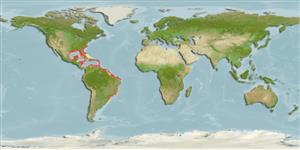>
Pleuronectiformes (Flatfishes) >
Cynoglossidae (Tonguefishes) > Symphurinae
Etymology: Symphurus: Greek, syn, symphysis = grown together + Greek, oura = tail (Ref. 45335); diomedeanus: Named for the Greek hero in the Trojan Was, Diomedes..
More on authors: Goode & Bean.
Environment: milieu / climate zone / depth range / distribution range
Ecologia
marino associati a barriera corallina; distribuzione batimetrica 6 - 263 m (Ref. 5951), usually 21 - 80 m (Ref. 26268). Subtropical; 36°N - 40°S, 98°W - 35°W (Ref. 26268)
Western Atlantic: Canada (Ref. 5951) to north of Cape Hatteras, North Carolina through the Gulf of Mexico and the Caribbean Sea, inner continental shelf of South America to about Isla de Flores, Uruguay.
Size / Peso / Age
Maturity: Lm ? range ? - ? cm
Max length : 22.0 cm TL maschio/sesso non determinato; (Ref. 35237); common length : 18.0 cm TL maschio/sesso non determinato; (Ref. 3716)
Spine dorsali (totale) : 0; Raggi dorsali molli (totale) : 90 - 92; Spine anali: 0; Raggi anali molli: 73 - 77.
Does not usually occur in shallow coastal or estuarine waters (Ref. 26268). Found on muddy bottoms. Feeds mainly on various benthic invertebrates particularly crabs and polychaete worms (Ref. 35237).
Life cycle and mating behavior
Maturities | Riproduzione | Spawnings | Egg(s) | Fecundities | Larve
Robins, C.R. and G.C. Ray, 1986. A field guide to Atlantic coast fishes of North America. Houghton Mifflin Company, Boston, U.S.A. 354 p. (Ref. 7251)
IUCN Red List Status (Ref. 130435)
Threat to humans
Harmless
Human uses
Pesca: di potenziale interesse
Strumenti
Special reports
Download XML
Fonti Internet
Estimates based on models
Preferred temperature (Ref.
123201): 19.7 - 27.5, mean 24.7 °C (based on 270 cells).
Phylogenetic diversity index (Ref.
82804): PD
50 = 0.5000 [Uniqueness, from 0.5 = low to 2.0 = high].
Bayesian length-weight: a=0.01445 (0.00647 - 0.03228), b=3.05 (2.85 - 3.25), in cm total length, based on LWR estimates for this (Sub)family-body shape (Ref.
93245).
Trophic level (Ref.
69278): 3.3 ±0.46 se; based on food items.
Resilienza (Ref.
120179): Alto, tempo minimo di raddoppiamento della popolazione meno di 15 mesi (Preliminary K or Fecundity.).
Fishing Vulnerability (Ref.
59153): Low vulnerability (12 of 100).
Nutrients (Ref.
124155): Calcium = 45.3 [16.1, 119.5] mg/100g; Iron = 0.626 [0.277, 1.200] mg/100g; Protein = 19 [17, 21] %; Omega3 = 0.148 [0.072, 0.304] g/100g; Selenium = 21.2 [9.7, 48.3] μg/100g; VitaminA = 33.3 [7.2, 163.2] μg/100g; Zinc = 0.756 [0.455, 1.169] mg/100g (wet weight);
